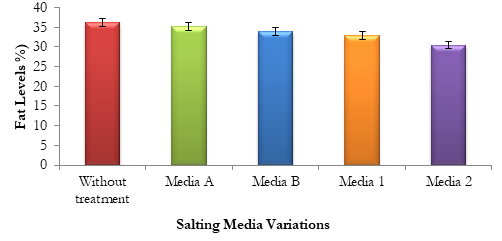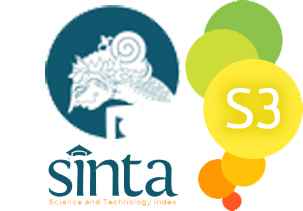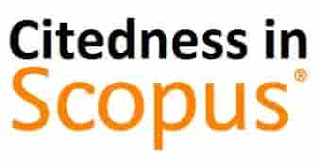The Effect of Variations of Red Bricks, Sand, Sawdust, and Green Tea (Camellia sinensis) Media on the Fat Content of Salted Egg Yolks
Abstract
Salting is done to extend the shelf life of duck eggs. A variety of media can be used for salting eggs, including a mixture of salt, sand, red brick, sawdust, and brewed tea. Salted eggs are popular among the general public, but they contain a lot of fat, which, if consumed in excess, can cause blood vessel blockage (atherosclerosis). Green tea is a plant that has many benefits, one of which is that it can help people lose weight. Duck eggs were ripened for 12 days in a variety of salting media with different ingredients for this study. Red bricks, sand, sawdust, salt, and brewed green tea are among the materials used. This study aimed to determine the fat content of salted egg yolks using the Soxhlet extraction method, as well as the color, aroma (smell), and taste of salted eggs. The data in this study were analyzed using One-Way ANOVA and the results revealed that variations in salting media had a significant effect on fat content in salted egg yolks. The results showed the changes in fat content in salted egg yolks without treatment with a fat content of 36.28 percent, and with treatment with media A (sand, red bricks, and sawdust); media B (sand, red bricks, and sawdust); media 1 (media A added with green tea); and media 2 (media B added with green tea), with the fat contents of 35.22%; 32.86%, and 30.49%. Mixed media of green tea affects the fat content of salted egg yolks, from 36.50% to 32.86% and 30.49%.
References
Balci, F. & Ozdemir, F. (2016). Influence of shooting period and extraction conditions on bioactive compounds in Turkish green tea. Journal Food Science and Technology. 36(4):737-743. https://doi.org/10.1590/1678-457X.17016
Dayurani, R., Mardiati, S. M., & Djaelani, M. A. (2019). Kadar Lemak, Indeks Kuning Telur, dan Susut Bobot Telur Itik setelah Pencucian Air dan Perendaman Ekstrak Daun Jambu Biji (Psidium guajava). Buletin Anatomi dan Fisiologi, 4(1), 35-44. https://doi.org/10.14710/baf.4.1.2019.35-44
Fajar, R., Wrasiati, L., & Suhendra, L. (2018). Kandungan Senyawa Flavonoid Dan Aktivitas Antioksidan Ekstrak Teh Hijau Pada Perlakuan Suhu Awal Dan Lama Penyeduhan. Jurnal Rekayasa Dan Manajemen Agroindustri, 6(3), 196-202. https://doi.org/10.24843/JRMA.2018.v06.i03.p02
Hakim, L., Valentinus, P.B., Bambang, D. (2017). Kandungan Lemak, Tekstur Kemasiran dan Kesukaan Telur Asin dengan Penambahan Jahe sebagai Penyedap. Jurnal Aplikasi Teknologi Pangan 6 (3), 124-128. http://dx.doi.org/10.17728/jatp.199
Ketaren, S. (2012). Pengantar Teknologi Minyak dan Lemak Pangan. Jakarta: UI Press.
Kurniati, D., Bintoro, V. P., & Dwiloka, B. (2020). Pengaruh Perendaman dalam Teh Hijau Dan Teh Hitam Terhadap Kadar Air, Kadar Lemak, Kadar Protein, dan Mutu Hedonik Telur Itik Rebus. Journal of Nutrition College, 9(3), 197-201.
https://doi.org/10.14710/jnc.v9i3.26947
Kusumaningrum and Yudanto. (2009). Pembuatan Briket Bioarang Dari Arang Serbuk Gergaji Kayu Jati. Jurusan Teknik Kimia, Fakultas Teknik, Universitas Diponegoro. http://eprints.undip.ac.id/3682/
Muharlien. (2010). Meningkatkan Kualitas Telur Melalui Penambahan Teh Hijau Dalam Pakan Ayam Petelur. Jurnal Ilmu dan Teknologi Hasil Ternak, 5(1): 32-37.
Silondae, H. and Ulpah, A. (2015). Peningkatan Telur Ayam Ras dengan Perendaman dalam Larutan Teh. Jurnal Penelitian Pascapanen Pertanian | Volume 12 No.3 Desember 2015 : 124 - 128
Yuniati, H., Almasyhuri. (2012). Pengaruh perbedaan media dan waktu pengasinan pada pembuatan telur asin terhadap kandungan iodium telur. Media Litbang Kesehatan, 22(3), 138-143.
Zulaekah, S dan E. N. Widiyaningsih. (2005). Pengaruh Konsentrasi Ekstrak Daun Teh pada Pembuatan Telur Asin Rebus Terhadap Jumlah Bakteri dan Daya Terimanya. Jurnal Penelitian Sains dan Teknologi, 6(1): 1-13.
Wulandari, R. and Rahmanisa, S. (2016). Pengaruh Ekstrak Teh Hijau Terhadap Penurunan Berat Badan pada Remaja. Jurnal Majority, 5 (2):106 – 111.























